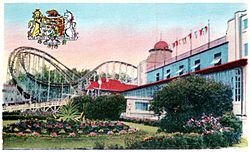Crystal Beach Cyclone facts for kids
Quick facts for kids Crystal Beach Cyclone |
|
|---|---|

Postcard image of the Cyclone, next to the Crystal Ball Room.
|
|
| Crystal Beach Park | |
| Location | Crystal Beach Park |
| Park section | Cyclone Bay |
| Coordinates | 42°51′42″N 79°03′35″W / 42.861699°N 79.059844°W |
| Status | Demolished |
| Opening date | 1927 |
| Closing date | September 2, 1946 |
| Cost | $176,000 CDN |
| General statistics | |
| Type | Wood |
| Manufacturer | Traver Engineering |
| Designer | Harry G. Traver |
| Track layout | Twister |
| Lift/launch system | Chain-lift |
| Height | 96 ft (29 m) |
| Drop | 90 ft (27 m) |
| Length | 2,953 ft (900 m) |
| Speed | 60 mph (97 km/h) |
| Duration | 1:10 |
| Max vertical angle | 59° |
| Capacity | 85 riders per hour |
| G-force | 4 |
| Crystal Beach Cyclone at RCDB | |
The Crystal Beach Cyclone was a super exciting and intense roller coaster built in the 1920s. It was designed by a famous engineer named Harry G. Traver. This amazing ride was found at Crystal Beach Park in Ontario, Canada. It was known as one of Traver's "Terrifying Triplets" because it was so wild!
Contents
The Story of the Cyclone
The Crystal Beach Cyclone was part of a special group of three roller coasters. These were called the "Terrifying Triplets." The Crystal Beach Cyclone and the Lightning in Revere Beach both opened in 1927. Another "Cyclone" was built in 1928 at Palisades Park.
The Crystal Beach Cyclone was the most famous of the three. It also lasted the longest. It was taken down in September 1946. This happened because it cost a lot to keep it running. Not as many people were riding it anymore. Some of its wood and steel were later used to build another coaster, The Comet, in 1948.
How the Cyclone Was Built
Building the Cyclone took a lot of materials. Over 225 tonnes (that's like 225,000 kilograms!) of metal were used. It had a strong steel frame, which was different from most wooden coasters. Even with the steel frame, it's still called a "woodie." This is because its track was made from wood.
About 6,100 meters of wood were used for the track. This wood came from British Columbia fir trees. At night, 1,000 small light bulbs made the ride glow.
Riding the Cyclone: The Layout
The Cyclone's track was twisted and wild. It had many curved and steep drops. Some turns were banked (tilted) at up to 80 degrees! Imagine leaning that much! The trains went through many spiraling turns and figure-8 sections.
There were almost no brakes on the ride outside of the station. This was because there were no flat parts of the track where brakes could be placed. There was one small brake between a spiral and a figure-8 section.
Exciting Ride Features
Here are some of the cool things you would experience on the Cyclone:
- A curve out of the station to the lift hill.
- The chain lift that pulled you to the top.
- A spiraling first drop that was about 90 feet tall!
- A second hill that was about 82 feet high.
- A sudden left turn into a second drop at 52 degrees.
- Another spiraling drop.
- A steep drop into a super-fast figure-eight section.
- More drops and small "hops" under the lift hill.
- A fast 210-degree turn under the coaster's main structure.
- A "zigzag" or "jazz twister" track, now called trick track.
- A series of tiny "bunny hops" that felt like small bumps. These led you back to the station.
Small Differences in Design
All three "Terrifying Triplets" coasters were very similar. They had the same basic layout. The main difference was that the spiral on the Palisades Cyclone was even tighter. This was because that park had less space.
How the Ride Operated
The Cyclone usually ran with one or two trains. Each train had three or five cars, depending on how many people were there. Later, trains were always kept to three cars. This helped reduce the stress on the ride's structure.
The ride itself lasted about 40 seconds. If you add the time it took to get to the top of the lift hill, the total ride time was about 70 seconds. On opening day, about 75,000 people came to Crystal Beach to see the Cyclone! The crowds were so big that a railing broke from people pushing to get closer. One person rode the Cyclone 67 times that day! The next day, two boys rode it 52 times.
Keeping the Ride Running
These powerful roller coasters were tough to maintain. The high forces they created put a lot of strain on the structure. Even with shorter trains, the track still suffered. One person who worked at Palisades Park said their Cyclone rarely ran every day. It often had problems that kept it from opening regularly.
In 1938, the Crystal Beach Cyclone got a big update. Many extra support beams were added to make it stronger.
The Thrilling Ride Experience
Speed and G-Forces
The Cyclone was known for being very intense. Riders could feel over 4 Gs of force. G-force is a measure of acceleration, like how much you're pushed into your seat. For comparison, astronauts feel about 3 Gs during a rocket launch! The Cyclone's top speed was said to be close to 97 kilometers per hour (60 miles per hour).

